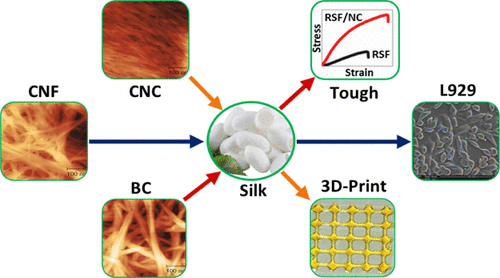当前位置:
X-MOL 学术
›
ACS Sustain. Chem. Eng.
›
论文详情
Our official English website, www.x-mol.net, welcomes your
feedback! (Note: you will need to create a separate account there.)
Tunable Biomimetic Hydrogels from Silk Fibroin and Nanocellulose
ACS Sustainable Chemistry & Engineering ( IF 7.1 ) Pub Date : 2020-02-06 , DOI: 10.1021/acssuschemeng.9b05317 Pramod Dorishetty 1 , Rajkamal Balu 1 , Sandya S. Athukoralalage 1 , Tamar L. Greaves 2 , Jitendra Mata 3 , Liliana de Campo 3 , Nabanita Saha 4 , Andrew C. W. Zannettino 5, 6 , Naba K. Dutta 1, 7 , Namita Roy Choudhury 1, 7
ACS Sustainable Chemistry & Engineering ( IF 7.1 ) Pub Date : 2020-02-06 , DOI: 10.1021/acssuschemeng.9b05317 Pramod Dorishetty 1 , Rajkamal Balu 1 , Sandya S. Athukoralalage 1 , Tamar L. Greaves 2 , Jitendra Mata 3 , Liliana de Campo 3 , Nabanita Saha 4 , Andrew C. W. Zannettino 5, 6 , Naba K. Dutta 1, 7 , Namita Roy Choudhury 1, 7
Affiliation

|
Biomimetic hydrogels offer a new platform for hierarchical structure-controlled, tough, biocompatible, mechanically tunable, and printable gels for regenerative medicine. Herein, we report for the first time the detailed effects of various kinds of nanocellulose, namely, bacterial nanocellulose, cellulose nanofibers, and cellulose nanocrystals on the morphology, structure–property relationship, and 3D printability of the photochemically cross-linked regenerated silk fibroin (RSF)/nanocellulose composite hydrogels. The hierarchical structure of fabricated biomimetic hydrogels was both qualitatively and quantitatively investigated by scanning electron microscopy and small/ultrasmall-angle neutron scattering, whereas their mechanical properties were assessed using rheology, tensile, and indentation tests. The micropore size and interhydrophobic domain distance of fabricated hydrogels were tuned in the range of 1.8–9.2 μm and 4.5–17.7 nm, respectively. The composite hydrogels exhibit superior viscoelastic, compressive, and tensile mechanical properties compared to pristine RSF hydrogel, where the shear storage modulus, compression modulus, young’s modulus, and tensile toughness were tuned in the range of 0.4–1.4, 1.3–3.6, 2.2–14.0 MPa, and 16.7–108.3 kJ/m3, respectively. Moreover, the obtained mechanical modulus of the composite hydrogels in terms of shear, tensile, and compression are comparable to articular cartilage (0.4–1.6 MPa), native femoral artery (∼9.0 MPa), and human medial meniscus (∼1.0 MPa) tissues, respectively, which demonstrate their potential for a wide range of tissue engineering applications. The whisker form of nanocellulose was observed to enhance the printability of composite hydrogels, whereas the fiber form enhanced the overall toughness of the composite hydrogels and promoted the fibroblast cell attachment, viability, and proliferation. The results presented here have implications for both fundamental understanding and potential applications of RSF/nanocellulose composite hydrogels for 3D-printed scaffolds and tissue engineering.
中文翻译:

丝素蛋白和纳米纤维素的可调仿生水凝胶
仿生水凝胶为再生医学的分级结构控制的,坚韧的,生物相容的,机械可调的和可印刷的凝胶提供了新的平台。在此,我们首次报告细菌纳米纤维素,纤维素纳米纤维和纤维素纳米晶体等各种纳米纤维素对光化学交联的再生丝素蛋白的形态,结构-性能关系和3D可印刷性的详细影响( RSF)/纳米纤维素复合水凝胶。通过扫描电子显微镜和小/超小角度中子散射定性和定量研究了仿生水凝胶的层级结构,同时使用流变学,拉伸和压痕测试评估了它们的机械性能。制备的水凝胶的微孔尺寸和疏水域间距离分别在1.8–9.2μm和4.5–17.7 nm范围内调整。与原始的RSF水凝胶相比,复合水凝胶显示出优异的粘弹性,压缩和拉伸机械性能,其中的储能模量,压缩模量,杨氏模量和拉伸韧性在0.4–1.4、1.3–3.6、2.2– 14.0 MPa和16.7–108.3 kJ / m3,分别。此外,在剪切,拉伸和压缩方面获得的复合水凝胶的机械模量可与关节软骨(0.4–1.6 MPa),股骨天然动脉(〜9.0 MPa)和人内侧半月板(〜1.0 MPa)组织相媲美。分别展示了它们在广泛的组织工程应用中的潜力。观察到晶须形式的纳米纤维素增强了复合水凝胶的可印刷性,而纤维形式增强了复合水凝胶的整体韧性并促进了成纤维细胞的附着,生存能力和增殖。本文介绍的结果对于RSF /纳米纤维素复合水凝胶在3D打印支架和组织工程中的基础理解和潜在应用都有影响。
更新日期:2020-02-07
中文翻译:

丝素蛋白和纳米纤维素的可调仿生水凝胶
仿生水凝胶为再生医学的分级结构控制的,坚韧的,生物相容的,机械可调的和可印刷的凝胶提供了新的平台。在此,我们首次报告细菌纳米纤维素,纤维素纳米纤维和纤维素纳米晶体等各种纳米纤维素对光化学交联的再生丝素蛋白的形态,结构-性能关系和3D可印刷性的详细影响( RSF)/纳米纤维素复合水凝胶。通过扫描电子显微镜和小/超小角度中子散射定性和定量研究了仿生水凝胶的层级结构,同时使用流变学,拉伸和压痕测试评估了它们的机械性能。制备的水凝胶的微孔尺寸和疏水域间距离分别在1.8–9.2μm和4.5–17.7 nm范围内调整。与原始的RSF水凝胶相比,复合水凝胶显示出优异的粘弹性,压缩和拉伸机械性能,其中的储能模量,压缩模量,杨氏模量和拉伸韧性在0.4–1.4、1.3–3.6、2.2– 14.0 MPa和16.7–108.3 kJ / m3,分别。此外,在剪切,拉伸和压缩方面获得的复合水凝胶的机械模量可与关节软骨(0.4–1.6 MPa),股骨天然动脉(〜9.0 MPa)和人内侧半月板(〜1.0 MPa)组织相媲美。分别展示了它们在广泛的组织工程应用中的潜力。观察到晶须形式的纳米纤维素增强了复合水凝胶的可印刷性,而纤维形式增强了复合水凝胶的整体韧性并促进了成纤维细胞的附着,生存能力和增殖。本文介绍的结果对于RSF /纳米纤维素复合水凝胶在3D打印支架和组织工程中的基础理解和潜在应用都有影响。











































 京公网安备 11010802027423号
京公网安备 11010802027423号